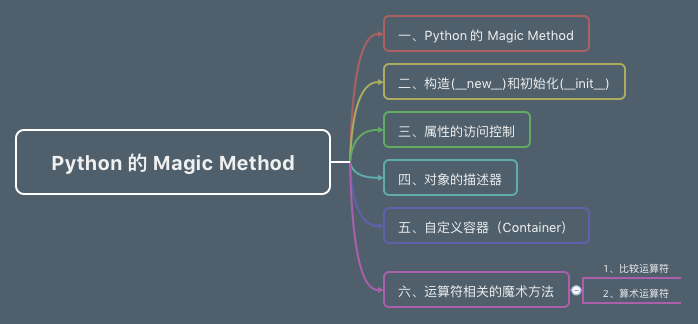四、对象的描述器
一般来说,一个描述器是一个有“绑定行为”的对象属性 (object attribute),它的访问控制被描述器协议方法重写。
这些方法是 __get__(), __set__() , 和 __delete__() 。
有这些方法的对象叫做描述器。
默认对属性的访问控制是从对象的字典里面 (__dict__) 中获取 (get) , 设置 (set) 和删除 (delete) 。
举例来说, a.x 的查找顺序是, a.__dict__['x'] , 然后 type(a).__dict__['x'] , 然后找 type(a) 的父类 ( 不包括元类 (metaclass) ).如果查找到的值是一个描述器, Python 就会调用描述器的方法来重写默认的控制行为。
这个重写发生在这个查找环节的哪里取决于定义了哪个描述器方法。
注意, 只有在新式类中时描述器才会起作用。在之前的篇节中已经提到新式类和旧式类的,有兴趣可以查看之前的篇节来看看,至于新式类最大的特点就是所有类都继承自 type 或者 object 的类。
在面向对象编程时,如果一个类的属性有相互依赖的关系时,使用描述器来编写代码可以很巧妙的组织逻辑。在 Django 的 ORM 中,models.Model 中的 InterField 等字段, 就是通过描述器来实现功能的。
我们先看下下面的例子:
#!/usr/bin/env python3
# -*- coding: UTF-8 -*-
class User(object):
def __init__(self, name='两点水', sex='男'):
self.sex = sex
self.name = name
def __get__(self, obj, objtype):
print('获取 name 值')
return self.name
def __set__(self, obj, val):
print('设置 name 值')
self.name = val
class MyClass(object):
x = User('两点水', '男')
y = 5
if __name__ == '__main__':
m = MyClass()
print(m.x)
print('\n')
m.x = '三点水'
print(m.x)
print('\n')
print(m.x)
print('\n')
print(m.y)
输出的结果如下:
获取 name 值 两点水 设置 name 值 获取 name 值 三点水 获取 name 值 三点水 5
通过这个例子,可以很好的观察到这 __get__() 和 __set__() 这些方法的调用。
再看一个经典的例子
我们知道,距离既可以用单位"米"表示,也可以用单位"英尺"表示。 现在我们定义一个类来表示距离,它有两个属性: 米和英尺。
#!/usr/bin/env python3
# -*- coding: UTF-8 -*-
class Meter(object):
def __init__(self, value=0.0):
self.value = float(value)
def __get__(self, instance, owner):
return self.value
def __set__(self, instance, value):
self.value = float(value)
class Foot(object):
def __get__(self, instance, owner):
return instance.meter * 3.2808
def __set__(self, instance, value):
instance.meter = float(value) / 3.2808
class Distance(object):
meter = Meter()
foot = Foot()
if __name__ == '__main__':
d = Distance()
print(d.meter, d.foot)
d.meter = 1
print(d.meter, d.foot)
d.meter = 2
print(d.meter, d.foot)
输出的结果:
0.0 0.0 1.0 3.2808 2.0 6.5616
在上面例子中,在还没有对 Distance 的实例赋值前, 我们认为 meter 和 foot 应该是各自类的实例对象, 但是输出却是数值。这是因为 __get__ 发挥了作用.
我们只是修改了 meter ,并且将其赋值成为 int ,但 foot 也修改了。这是 __set__ 发挥了作用.
描述器对象 (Meter、Foot) 不能独立存在, 它需要被另一个所有者类 (Distance) 所持有。描述器对象可以访问到其拥有者实例的属性,比如例子中 Foot 的 instance.meter 。
五、自定义容器(Container)
经过之前编章的介绍,我们知道在 Python 中,常见的容器类型有: dict, tuple, list, string。其中也提到过可容器和不可变容器的概念。其中 tuple, string 是不可变容器,dict, list 是可变容器。
可变容器和不可变容器的区别在于,不可变容器一旦赋值后,不可对其中的某个元素进行修改。当然具体的介绍,可以看回之前的文章,有图文介绍。
那么这里先提出一个问题,这些数据结构就够我们开发使用吗?
不够的时候,或者说有些特殊的需求不能单单只使用这些基本的容器解决的时候,该怎么办呢?
这个时候就需要自定义容器了,那么具体我们该怎么做呢?
| 功能 | 说明 |
|---|---|
| 自定义不可变容器类型 | 需要定义 __len__ 和 __getitem__ 方法 |
| 自定义可变类型容器 | 在不可变容器类型的基础上增加定义 __setitem__ 和 __delitem__ |
| 自定义的数据类型需要迭代 | 需定义 __iter__ |
| 返回自定义容器的长度 | 需实现 __len__(self) |
自定义容器可以调用 self[key] ,如果 key 类型错误,抛出TypeError ,如果没法返回key对应的数值时,该方法应该抛出ValueError | 需要实现 __getitem__(self, key) |
当执行 self[key] = value 时 | 调用是 __setitem__(self, key, value)这个方法 |
当执行 del self[key] 方法 | 其实调用的方法是 __delitem__(self, key) |
当你想你的容器可以执行 for x in container: 或者使用 iter(container) 时 | 需要实现 __iter__(self) ,该方法返回的是一个迭代器 |
来看一下使用上面魔术方法实现 Haskell 语言中的一个数据结构:
#!/usr/bin/env python3
# -*- coding: UTF-8 -*-
class FunctionalList:
''' 实现了内置类型list的功能,并丰富了一些其他方法: head, tail, init, last, drop, take'''
def __init__(self, values=None):
if values is None:
self.values = []
else:
self.values = values
def __len__(self):
return len(self.values)
def __getitem__(self, key):
return self.values[key]
def __setitem__(self, key, value):
self.values[key] = value
def __delitem__(self, key):
del self.values[key]
def __iter__(self):
return iter(self.values)
def __reversed__(self):
return FunctionalList(reversed(self.values))
def append(self, value):
self.values.append(value)
def head(self):
# 获取第一个元素
return self.values[0]
def tail(self):
# 获取第一个元素之后的所有元素
return self.values[1:]
def init(self):
# 获取最后一个元素之前的所有元素
return self.values[:-1]
def last(self):
# 获取最后一个元素
return self.values[-1]
def drop(self, n):
# 获取所有元素,除了前N个
return self.values[n:]
def take(self, n):
# 获取前N个元素
return self.values[:n]
六、运算符相关的魔术方法
运算符相关的魔术方法实在太多了,j就大概列举下面两类:
1、比较运算符
| 魔术方法 | 说明 |
|---|---|
__cmp__(self, other) | 如果该方法返回负数,说明 self < other; 返回正数,说明 self > other; 返回 0 说明 self == other 。强烈不推荐来定义 __cmp__ , 取而代之, 最好分别定义 __lt__, __eq__ 等方法从而实现比较功能。 __cmp__ 在 Python3 中被废弃了。 |
__eq__(self, other) | 定义了比较操作符 == 的行为 |
__ne__(self, other) | 定义了比较操作符 != 的行为 |
__lt__(self, other) | 定义了比较操作符 < 的行为 |
__gt__(self, other) | 定义了比较操作符 > 的行为 |
__le__(self, other) | 定义了比较操作符 <= 的行为 |
__ge__(self, other) | 定义了比较操作符 >= 的行为 |
来看个简单的例子就能理解了:
#!/usr/bin/env python3
# -*- coding: UTF-8 -*-
class Number(object):
def __init__(self, value):
self.value = value
def __eq__(self, other):
print('__eq__')
return self.value == other.value
def __ne__(self, other):
print('__ne__')
return self.value != other.value
def __lt__(self, other):
print('__lt__')
return self.value < other.value
def __gt__(self, other):
print('__gt__')
return self.value > other.value
def __le__(self, other):
print('__le__')
return self.value <= other.value
def __ge__(self, other):
print('__ge__')
return self.value >= other.value
if __name__ == '__main__':
num1 = Number(2)
num2 = Number(3)
print('num1 == num2 ? --------> {} \n'.format(num1 == num2))
print('num1 != num2 ? --------> {} \n'.format(num1 == num2))
print('num1 < num2 ? --------> {} \n'.format(num1 < num2))
print('num1 > num2 ? --------> {} \n'.format(num1 > num2))
print('num1 <= num2 ? --------> {} \n'.format(num1 <= num2))
print('num1 >= num2 ? --------> {} \n'.format(num1 >= num2))
输出的结果为:
__eq__ num1 == num2 ? --------> False __eq__ num1 != num2 ? --------> False __lt__ num1 < num2 ? --------> True __gt__ num1 > num2 ? --------> False __le__ num1 <= num2 ? --------> True __ge__ num1 >= num2 ? --------> False
2、算术运算符
| 魔术方法 | 说明 |
|---|---|
__add__(self, other) | 实现了加号运算 |
__sub__(self, other) | 实现了减号运算 |
__mul__(self, other) | 实现了乘法运算 |
__floordiv__(self, other) | 实现了 // 运算符 |
___div__(self, other) | 实现了/运算符. 该方法在 Python3 中废弃. 原因是 Python3 中,division 默认就是 true division |
__truediv__(self, other) | 实现了 true division. 只有你声明了 from __future__ import division 该方法才会生效 |
__mod__(self, other) | 实现了 % 运算符, 取余运算 |
__divmod__(self, other) | 实现了 divmod() 內建函数 |
__pow__(self, other) | 实现了 ** 操作. N 次方操作 |
__lshift__(self, other) | 实现了位操作 << |
__rshift__(self, other) | 实现了位操作 >> |
__and__(self, other) | 实现了位操作 & |
__or__(self, other) | 实现了位操作 ` |
__xor__(self, other) | 实现了位操作 ^ |








 本文详细介绍了Python中的描述器如何重写属性访问控制,自定义不可变和可变容器的实现,以及运算符相关魔术方法的使用,如__get__,__set__,__delitem__和比较/算术运算符的定义。
本文详细介绍了Python中的描述器如何重写属性访问控制,自定义不可变和可变容器的实现,以及运算符相关魔术方法的使用,如__get__,__set__,__delitem__和比较/算术运算符的定义。















 681
681

 被折叠的 条评论
为什么被折叠?
被折叠的 条评论
为什么被折叠?








